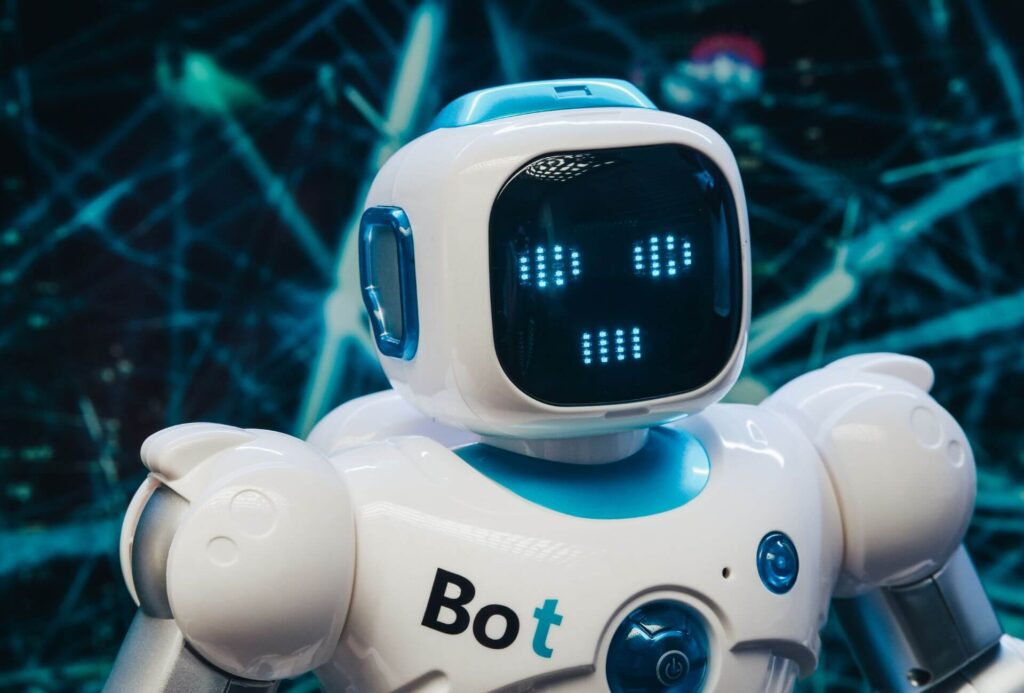Artificial Intelligence (AI) – Understand What It Is And How It Works
Welcome to the intriguing world of Artificial Intelligence (AI). Artificial Intelligence (AI) is a rapidly evolving field that has the potential to revolutionize various industries and impact our daily lives.
Prepare to embark on a captivating journey as we unravel the secrets behind this revolutionary technology. In this article, we will delve into the depths of AI, exploring its inner workings and shedding light on its remarkable capabilities.
Whether you’re a curious explorer or a knowledge seeker, join us as we demystify the enigma of AI and gain a deeper understanding of what it truly entails. So, fasten your seatbelts and get ready to immerse yourself in the extraordinary world of Artificial Intelligence.
In summary:
- Embark on a captivating journey to unravel Artificial Intelligence’s (AI) secrets.
- Gain a deeper understanding of AI’s inner workings and remarkable capabilities.
- Demystify the enigma of AI and explore its true essence.
- Prepare to be amazed as we delve into the extraordinary world of Artificial Intelligence.

What is artificial intelligence (AI)?
Artificial Intelligence (AI) is a remarkable field that has captivated the imaginations of scientists, researchers, and enthusiasts alike. It encompasses many concepts and technologies that strive to mimic human intelligence and cognition. But what indeed lies at the core of artificial intelligence?
At its essence, artificial intelligence refers to the development of intelligent machines that can perform tasks requiring human-like intelligence. These tasks span a vast spectrum, ranging from simple calculations to complex problem-solving and decision-making.
AI systems aim to exhibit traits such as learning, reasoning, perception, and adaptation, enabling them to navigate the intricacies of our world.
The beauty of artificial intelligence lies in its ability to learn from experience and adjust its behavior accordingly. Through sophisticated algorithms, data analysis, and pattern recognition, AI systems can make sense of vast information, extracting meaningful insights and providing valuable solutions.
However, it is essential to note that artificial intelligence is not a monolithic entity. It encompasses various subfields and approaches, each with unique characteristics and methodologies. These include machine learning, deep learning, natural language processing, computer vision, and more.
In essence, artificial intelligence represents the relentless pursuit of creating machines that can mimic and sometimes surpass human intelligence. It is an ever-evolving field that pushes the boundaries of what is possible, continually challenging us to redefine our understanding of intelligence and the capabilities of machines.
How To Use AI?
Discovering the incredible potential of Artificial Intelligence (AI) opens up a world of opportunities to leverage its power in various domains. But how does one go about harnessing the capabilities of AI? Let’s dive into the realm of practicality and explore how to use AI in your endeavors effectively.
- Identify Needs and Goals: Start by identifying your specific needs and goals. Determine the areas where AI can significantly impact, whether it’s automating repetitive tasks, enhancing decision-making processes, or uncovering valuable insights from vast amounts of data.
- Define Data Requirements: AI thrives on data. Identify the type and quality of data required to train and improve your AI models. Clean, relevant, and diverse datasets are crucial to achieving accurate and reliable results.
- Select the Right AI Techniques: Familiarize yourself with AI techniques such as machine learning, deep learning, natural language processing, and computer vision. Understand their strengths and limitations, and choose the best approach to your objectives.
- Acquire or Generate Training Data: Depending on your application, you may need to acquire training data from external sources or generate synthetic data to train your AI models effectively. Ensure the data is representative of the problem you’re addressing.
- Prepare and Preprocess Data: Prepare the acquired or generated data by cleaning, organizing, and preprocessing it. This step involves tasks like data cleaning, feature engineering, and normalization to ensure the optimal performance of your AI models.
- Develop AI Models: Utilize AI frameworks and libraries to develop and train your models. Implement suitable algorithms, architecture designs, and optimization techniques to achieve the desired outcomes. Experimentation and iteration are key to refining and improving your models.
- Validate and Evaluate Models: Perform thorough validation and evaluation of your AI models using appropriate metrics and techniques. This step ensures that your models generalize well to new data and deliver accurate results.
- Integrate AI into Workflow: Integrate your AI models into your existing workflow or applications. This may involve developing APIs, deploying AI models in cloud environments, or integrating them into software systems for seamless usage.
- Monitor and Update: Continuously monitor your AI models’ performance and gather user feedback. Regularly update and retrain your models to adapt to evolving data patterns and improve their accuracy and effectiveness.
- Ethical Considerations: As you leverage the power of AI, it is crucial to prioritize ethical considerations. Ensure fairness, transparency, and accountability in using AI, addressing issues like bias, privacy, and security.
By following these steps, you can confidently navigate the realm of AI, leveraging its capabilities to transform your operations, gain insights, and make informed decisions. Remember, AI is a tool that complements human intelligence, and its successful utilization requires a thoughtful and strategic approach.
So, venture forth with curiosity and embrace the possibilities that AI brings. Explore, experiment, and unlock the potential of this remarkable technology to drive innovation, efficiency, and growth in your endeavors.

Learn More:
- Develop Self-Discipline & Achieve Your Goals: Ultimate Guide For 2023
- The Role Of Artificial Intelligence In SEO In 2023: Use AI
- PewDiePie Net Worth 2023 – How He Became The #1 Most Subscribed Youtuber
- Gary Vaynerchuk Net Worth 2023: 10 Inspiring Lessons To Learn From Gary Vee
What are the different types of Artificial Intelligence (4)?
Artificial Intelligence (AI) encompasses diverse approaches and techniques, each with unique characteristics and capabilities. Let’s explore four types of AI and understand how they contribute to the field.
1. Reactive Machines:
Reactive machines represent the simplest form of AI. They operate solely based on the current input, without memory of past interactions. These systems excel at reacting to specific situations but need more ability to form or retain long-term knowledge.
They analyze incoming data, make decisions, and execute actions in real time without the ability to learn or improve over time.
2. Limited Memory:
As the name suggests, limited memory AI systems can retain and recall specific past experiences. They can use this stored information to enhance their decision-making processes.
While these systems can learn from historical data, their knowledge is confined to a limited timeframe. They are typically employed in tasks that require short-term memory, such as autonomous driving, where recent data is crucial for making informed choices.
3. Theory of Mind:
Theory of Mind AI is a more advanced form of artificial intelligence that aims to understand and simulate human-like mental states.
These systems can attribute beliefs, desires, intentions, and emotions to others, enabling them to comprehend and predict human behavior more accurately. While theory of mind AI has made significant progress, it is still an active area of research and development.
4. Self Awareness:
Self-aware AI refers to systems possessing a sense of self and possessing consciousness. Although this level of AI is mainly speculative and resides more in the realm of science fiction, researchers are exploring ways to imbue AI systems with self-awareness.
The ultimate goal is to create AI that understands the world around it and has a subjective experience of its existence.
It’s important to note that these types of AI represent a spectrum rather than discrete categories. AI systems often combine elements from multiple types, depending on their specific applications and objectives.
For example, a self-driving car may utilize reactive machine techniques for real-time decision-making, limited memory capabilities to remember recent events, and theory of mind principles to anticipate and respond to the behavior of other drivers.
Understanding the different types of AI is crucial for tailoring solutions to specific problems and harnessing their potential effectively. By utilizing the strengths of each type and considering the requirements of the task at hand, AI researchers and practitioners can develop sophisticated systems that push the boundaries of what is possible.
In summary:
- Reactive Machines operate based on the current input and lack memory of past interactions.
- Limited Memory AI systems can retain and recall past experiences to enhance decision-making.
- Theory of Mind AI aims to simulate human-like mental states, understanding and predicting human behavior.
- Self-aware AI, while still largely speculative, refers to systems with a sense of self and consciousness.
By exploring these different types of AI, we gain a deeper understanding of the field and its potential for transforming various industries and aspects of our lives.
What are some recent examples of AI?
AI is already revolutionizing various industries with its significant contributions. Let’s explore some recent examples that showcase the incredible potential of AI:
1. ChatGPT (and the GPTs):
OpenAI’s ChatGPT is an AI model that harnesses the power of natural language processing and machine learning to generate text responses that resemble a human conversation.
It can engage in meaningful dialogues and provide valuable information or assistance. This technology has been widely employed in customer service applications, virtual assistants, and content generation, transforming how businesses interact with customers.
2. Self-driving Cars:
Companies like Tesla and Waymo are at the forefront of developing self-driving car technology. These vehicles leverage AI algorithms to navigate roads and make real-time decisions.
With advanced sensors and machine learning algorithms, self-driving cars have the potential to enhance road safety by minimizing human error and improving transportation efficiency through optimized routes and traffic management.
3. Robotics:
AI-powered robots are revolutionizing industries such as manufacturing and healthcare. These robots can undertake complex tasks, collaborate with humans, and assist in areas like surgery, warehouse operations, and caregiving.
By combining human intelligence with AI capabilities, these robots enhance productivity, efficiency, and precision, leading to advancements in various fields.
4. DeepMind:
DeepMind, a subsidiary of Alphabet, has achieved remarkable milestones in AI research, particularly in reinforcement learning. Their AI systems have accomplished extraordinary feats, including defeating human champions in complex games like Go and Chess.
DeepMind’s breakthroughs in reinforcement learning have broader implications beyond gaming, such as optimizing energy usage, protein folding predictions, and drug discovery.
5. Google Maps:
AI algorithms power the functionalities of Google Maps, offering real-time traffic updates, route optimization, and personalized recommendations based on user preferences. This AI-powered navigation system has transformed how we navigate and explore the world, making travel more efficient and enjoyable.
6. Smart Assistants:
Virtual assistants like Siri, Alexa, and Google Assistant have become ubiquitous in our daily lives. These AI-powered assistants rely on advanced technologies like natural language processing and machine learning to understand and respond to voice commands.
They can perform tasks ranging from setting reminders and answering questions to controlling smart home devices, bringing convenience and efficiency to our daily routines.
7. Snapchat Filters:
Snapchat’s augmented reality filters, known as “Snapchat Filters,” utilize AI to detect and track facial features in real-time. By overlaying various effects and animations on users’ faces, these filters create engaging and entertaining experiences. It demonstrates the creative potential of AI in the realm of digital expression and entertainment.
8. Wearables:
AI integration in wearable devices, such as smartwatches and fitness trackers, has transformed how we monitor our health. These devices employ AI algorithms to track and analyze health data, provide personalized recommendations, and monitor physical activities.
By leveraging AI, wearables enable us to gain valuable insights into our fitness levels, sleep patterns, and overall well-being, empowering individuals to make informed decisions about their health.
9. MuZero:
DeepMind’s MuZero is an AI algorithm that combines reinforcement learning and tree search techniques. It has achieved impressive results in playing board games like Chess, Shogi, and Go without prior knowledge of the game rules.
MuZero’s capabilities extend beyond gaming, with potential applications in optimization problems, logistics, and decision-making processes.
These recent examples demonstrate AI’s diverse and transformative applications across various industries. As technology advances, we can anticipate even more exciting developments and groundbreaking innovations in the field of AI, leading to a future where AI plays an integral role in shaping our lives.


What is machine learning?
Machine learning is a fascinating field at the forefront of technological progress. It revolves around crafting algorithms that empower computers to learn and improve from data without explicit programming. These algorithms possess a remarkable aptitude for scrutinizing vast volumes of information, discerning patterns, and making astute predictions.
In contrast to traditional approaches reliant on fixed instructions, machine learning algorithms adapt and evolve by assimilating the data they encounter. They possess the capacity to discern subtle correlations and unearth concealed insights that might elude human observers.
This extraordinary capability has paved the way for novel opportunities in domains like image recognition, natural language processing, recommendation systems, and more.
Machine learning encompasses diverse techniques, including supervised, unsupervised, and reinforcement learning. Each approach exhibits distinctive characteristics and applications, permitting computers to learn from labeled data, identify patterns in unlabeled data, or engage with an environment to optimize decision-making.
Researchers confront data privacy, model interpretability, and fairness challenges as machine learning progresses. By addressing these concerns, we can fully harness the immense potential of machine learning and exploit it to enhance our lives in unprecedented ways.
What are the elements of machine learning?
Machine learning comprises several fundamental elements that serve as the building blocks for its diverse applications. These elements include supervised learning, unsupervised learning, and reinforcement learning.
Supervised Learning: involves training a model with labeled data where the desired output is already known. By exposing the model to this labeled data, it learns to make predictions or classify new, unseen instances accurately. This approach is akin to a teacher guiding a student by providing answers to specific questions.
Unsupervised Learning: In contrast, unsupervised learning involves working with unlabeled data, where the model independently explores and identifies patterns or structures.
It strives to uncover hidden relationships or groupings within the data without any pre-existing knowledge or guidance. Think of it as an explorer venturing into uncharted territory, discovering novel insights without a predefined map.
Reinforcement Learning: It takes inspiration from the concept of learning through trial and error. Here, an agent interacts with an environment and learns to make optimal decisions based on rewards or penalties.
The agent refines its behavior through exploration and exploitation to maximize long-term cumulative rewards. This element resembles a student engaging in hands-on experiments to acquire knowledge and refine their skills.
These elements form the backbone of machine learning, allowing algorithms to learn, adapt, and perform tasks without explicit instructions. Each element offers unique capabilities and finds applications in various domains, contributing to the advancement and versatility of machine learning as a whole.


What are large language models?
Large language models (LLMs) are advanced artificial intelligence systems created to comprehend and produce text closely resembling human language. LLMs gain a profound understanding of linguistic patterns and contextual nuances through extensive training on vast datasets containing books, articles, and web content.
They excel at processing information and generating coherent and contextually relevant text, making them invaluable for various applications like writing assistance, content creation, and language translation.
Leading LLMs, such as GPT-3.5 (the foundation of ChatGPT) and the upcoming GPT-4, can comprehend prompts, mimic human conversation, and provide detailed insights on diverse topics.
These LLMs are revolutionizing human-AI interactions, propelling the field of natural language processing forward, and unlocking new possibilities for effective communication. Google’s LaMDA, another prominent LLM, is utilized in Bard, making it the second-largest LLM.
What is deep learning?
Deep learning, a subset of AI, trains artificial neural networks with multiple layers to perform diverse tasks. These complex networks, composed of numerous deep layers, are trained using extensive datasets.
With more than three layers, deep-learning models can possess hundreds of layers, enabling them to recognize intricate patterns in data. This technology is widely applied in natural language processing (NLP), speech recognition, and image recognition.
By leveraging deep learning, AI systems acquire knowledge autonomously and improve performance over time, yielding refined results. Its ability to comprehend complex data representations has propelled advancements in AI research and development, revolutionizing various fields of application.
What are neural networks?
Neural networks are at the core of artificial intelligence, drawing inspiration from the intricate workings of the human brain. These mathematical models emulate the communication between neurons, forming interconnected nodes organized in layers. Their exceptional ability is to recognize patterns and extract meaningful information from complex data.
By undergoing “training,” neural networks adjust the connections between neurons, continually improving their performance. Various architectures, such as feedforward, recurrent, and convolutional networks, cater to specific tasks.
Feedforward networks analyze data in a forward direction, recurrent networks retain memory for sequential data, and convolutional networks excel at image and pattern recognition.
The impact of neural networks spans fields like computer vision, speech recognition, and natural language processing, revolutionizing how AI systems comprehend and interact with the world. Their adaptability and power are integral to the success of machine learning.
A helpful analogy is imagining a group of robots collaborating to solve a puzzle, where each robot specializes in recognizing a specific shape or color. Similarly, neural networks combine interconnected abilities to process data and produce desired outputs.
During training, neural networks learn from extensive databases, fine-tuning internal parameters to align their output with desired outcomes. This iterative process strives to accurately label objects in images or predict failures based on sensor data.
As neural networks continue to advance, their potential knows no bounds. They hold the key to unlocking new frontiers in AI, transforming industries, and shaping the future of technology.

What is conversational AI?
Conversational AI is a field within artificial intelligence that focuses on enabling computers to engage in human-like conversations. It aims to develop systems to understand, interpret, and generate language in a conversational context.
By utilizing natural language processing and machine learning techniques, conversational AI creates intelligent virtual agents, chatbots, and voice assistants capable of comprehending user queries, providing relevant information, and responding in a conversational manner.
This technology is transforming customer service, virtual assistants, and other applications that require interactive computer communication. Conversational AI bridges the gap between humans and machines, enhancing the seamlessness and intuitiveness of interactions.
It encompasses systems programmed to engage in conversations, utilizing natural language processing to understand and respond naturally. Examples include Google Bard chatbot, voice assistants like Amazon Alexa, and smartphone virtual assistants like Siri.
Which Types Of AI services are available to use?
A wide range of AI services caters to various needs and industries. Let’s explore some of the common types of AI services that are widely used today.
Voice assistants: Voice assistants have become increasingly popular and accessible, offering hands-free interaction and assistance through devices like smart speakers and smartphones.
These AI-powered assistants, such as Amazon Alexa, Google Assistant, and Apple Siri, can answer questions, set reminders, play music, control smart home devices, and simply respond to voice commands.
Chatbots: Chatbots are AI-based systems designed to simulate human-like conversations and provide instant assistance. They are often integrated into websites, messaging apps, and customer support platforms.
Chatbots can answer frequently asked questions, provide recommendations, assist with product inquiries, and even handle simple transactions. They offer a convenient and efficient way to engage customers, provide support, and streamline communication processes.
Language translation: Language translation services powered by AI have made bridging language barriers easier and facilitated global communication. These services use machine learning algorithms to analyze and translate text from one language to another.
Companies like Google, Microsoft, and DeepL offer AI-driven translation tools that accurately translate text documents, websites, and even real-time conversations.
Productivity: AI has significantly impacted productivity by automating repetitive tasks and enhancing efficiency. AI-powered productivity tools include:
- Smart email filters that prioritize essential messages.
- Virtual meeting assistants that schedule appointments.
- AI-driven project management platforms that optimize workflows and resource allocation.
These tools help individuals and teams streamline work, save time, and improve productivity.
Image and video recognition: Image and video recognition technologies employ AI algorithms to analyze and interpret visual content. They can identify objects, faces, landmarks, and even emotions within images or videos.
These AI services find applications in surveillance, content moderation, e-commerce, and augmented reality. Companies like Amazon Rekognition and Google Cloud Vision offer robust image and video recognition APIs that enable developers to integrate these capabilities into their applications.
Software development: AI has also found its way into software development, with automated coding tools that assist programmers in writing, debugging, and optimizing code.
These AI-powered tools use techniques like natural language processing and machine learning to understand code syntax, suggest improvements, and identify bugs, thereby enhancing the development process and reducing time and effort.
Building a business: AI services are also transforming the way businesses operate. From predictive analytics and demand forecasting to customer segmentation and personalized marketing campaigns, AI enables businesses to make data-driven decisions, optimize processes, and gain valuable insights.
It empowers organizations to automate repetitive tasks, improve customer experiences, and drive innovation.
These are just a few examples of the vast array of AI services available today. As technology advances, we expect AI to revolutionize industries further and provide innovative solutions to diverse challenges.

What company is leading the AI race?
When it comes to the AI race, several prominent companies have made significant contributions and are considered leaders in the field.
OpenAI
OpenAI, founded to ensure artificial general intelligence benefits all of humanity, is at the forefront of AI research and development. With its groundbreaking language models like GPT-3 and GPT-4, OpenAI has pushed the boundaries of natural language processing and demonstrated the power of large-scale language models in various applications.
Alphabet
Alphabet, the parent company of Google, is another major player in the AI arena. Google’s AI research division, Google Brain, has been instrumental in advancing AI technologies across multiple domains.
From pioneering breakthroughs in deep learning to developing cutting-edge applications like Google Assistant, Google has established itself as a frontrunner in the AI race.
Microsoft
Microsoft has made remarkable strides in the field with its focus on AI research and development. Through its Microsoft Research division and Azure cloud platform, the company has been instrumental in democratizing AI by providing accessible tools and services to developers and businesses.
Microsoft’s AI capabilities span across various domains, including natural language processing, computer vision, and machine learning.
Other companies
While OpenAI, Alphabet, and Microsoft are often recognized as leaders in the AI race, it’s essential to acknowledge that numerous other companies worldwide are making significant contributions.
Companies like IBM, Amazon, Facebook, Tencent, Baidu, Alibaba, Cruise, Lenovo, and Tesla have invested heavily in AI research and development, each bringing unique perspectives and expertise to advance the field.
The AI landscape is highly dynamic, with new players and startups emerging regularly, contributing to the advancement of AI technologies. The race to lead in AI is characterized by constant innovation and competition, with companies striving to push the boundaries of what AI can achieve.
Ultimately, it is challenging to single out one company as the definitive leader in the AI race. AI is a collaborative and evolving ecosystem where collective efforts from various organizations drive advancements. The
How will AI change the world?
The impact of AI on our world is poised to be transformative. As this remarkable technology continues to evolve, it brings myriad possibilities and changes that will shape our lives in ways we can only begin to imagine.
One of the most significant ways AI will change the world is through automation. With the ability to perform tasks quickly, accurately, and efficiently, AI-powered systems will revolutionize industries, increasing productivity and freeing up human resources for more creative and complex endeavors.
From autonomous vehicles to smart homes, AI will integrate seamlessly into our daily lives, simplifying routine tasks and enhancing overall convenience.
AI will also revolutionize healthcare, offering improved diagnostics, personalized treatments, and efficient patient care. By analyzing vast amounts of medical data and patterns, AI algorithms will assist doctors in making more accurate diagnoses and developing targeted therapies.
Additionally, AI-powered robots and devices will support eldercare and medical procedures, enhancing the quality of life and advancing the frontiers of medical science.
In communication and language, AI-powered translation tools and natural language processing algorithms will bridge linguistic barriers, fostering global connectivity and understanding.
AI chatbots and virtual assistants will become more sophisticated, providing personalized and context-aware interactions and transforming how we engage with technology and access information.
However, it’s essential to consider the ethical implications of AI. Ensuring privacy, transparency, and accountability will be crucial to harnessing the full potential of AI while safeguarding against potential risks and biases. Striking a balance between technological advancement and human well-being will be paramount as we navigate the AI-driven future.
Ultimately, AI promises to revolutionize industries, transform healthcare, enhance communication, and pave the way for a more connected and efficient world. As we embrace the potential of AI, it is essential to approach its development and deployment with responsibility and foresight, harnessing its power for the betterment of humanity.

Also check the following:
- 21 Best Ways To Make New Year Resolutions For Business Owners
- Jack Ma Net Worth 2023 – The Chinese Billionaire Net Worth In 2023
- Elon Musk Net Worth 2023 – Richest Person Or Richest Man On Earth According To Forbes?
- MrBeast Net Worth 2023: How He Gained Over 100 Million Subscribers As A YouTuber?
Pros and Cons of AI
Pros:
Cons:
- Ethical Concerns: As AI systems become more autonomous and make critical decisions, ethical considerations arise regarding issues such as privacy, bias, and accountability. Ensuring that AI systems are fair, transparent, and free from bias is a significant challenge that needs to be addressed.
- Job Displacement: The automation capabilities of AI may lead to job displacement in specific industries, as machines can perform tasks more efficiently and effectively. This calls for re-skilling and adapting the workforce to thrive in a future where AI plays a significant role.
- Security Risks: AI systems can be vulnerable to attacks and misuse. Adversarial attacks, where malicious actors manipulate AI systems to produce incorrect results, pose risks in areas such as cybersecurity and autonomous vehicles. Safeguarding AI systems against such threats is crucial.
Final Thoughts – What Is Artificial Intelligence (AI)?
Within the realm of Artificial Intelligence lies a vast realm of untapped potential, ready to reshape industries, elevate decision-making processes, and enhance our day-to-day existence. However, the path ahead has its challenges and ethical considerations.
Despite these hurdles, the rewards of AI in domains such as healthcare, transportation, and entertainment are undeniable. To fully leverage its capabilities, striking a delicate balance between innovation and responsible deployment is paramount.
By embracing a comprehensive understanding of the diverse facets of AI, recent applications, and its societal impact, we empower ourselves to navigate the future imbued with AI.
Continued exploration and open dialogue are essential as we unravel the profound implications and boundless possibilities it offers. This ongoing pursuit ensures that AI unfolds ethically and responsibly, guarding against unintended consequences and preserving our shared values.
As we embark on this extraordinary journey, let us embrace the transformative power of AI while remaining steadfast in our commitment to humanity.
We forge a path where innovation and human well-being intertwine by cultivating knowledge and awareness. With wisdom as our compass, we navigate the AI-powered future, harnessing its potential for the collective betterment of our global community.













